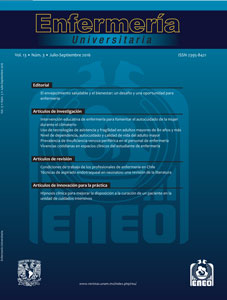Nursing students’ daily experiences in clinical spaces
Main Article Content
Abstract
Objective: To comprehend the daily experiences of nursing students in their clinical spaces.
Method: This is a qualitative study using a phenomenological method. Data were collected through 8 in-depth interviews to senior students enrolled in the Nursing Baccalaureate at the Nursing Superior School, Culiacan, Mexico. After gathering their corresponding informed consents, students were individually updated on the study development, always respecting the data confidentiality and veracity. The discourse analysis allowed to identify significant concepts, and assign them codes to form categories. The validation of the results included credibility, confirmability, and transferability.
Results: Preliminary results refer to the analysis of the first category, 1) meanings of the clinical space, with its three sub-categories: 1.1: satisfaction in the clinical spaces, 1.2: learning in the clinical spaces, and 1.3: symbolical figure in the clinical spaces.
Conclusions: Students expressed satisfaction and comfort because they go motivated to learn, and they perform novel activities in the clinical spaces. Also, the service nurse is a symbol of support and teaching within the clinical spaces. Nevertheless, while addressing their care duties, students stated that this learning is focused on planned and fragmented spaces and based on techniques and procedures such as vital signs readings, making beds, and medication dispensing.
Publication Facts
Reviewer profiles N/A
Author statements
- Academic society
- N/A
- Publisher
- Universidad Nacional Autónoma de México
Article Details
Dimensions citation
MÉTRICAS
Enfermería Universitaria by Universidad Nacional Autónoma de México it is distributed under the License Creative Commons Attribution - NonCommercial - NoDerivatives 4.0 International
Accepted and published articles become open-access under the terms of the Creative Commons CC BY-NC-ND 4.0 license, which authorizes the reproduction and sharing without commercial purposes, provided the corresponding acknowledgments to their authors. Authors are allowed to manage a self-archive copy of the article’s published version so that they can open-access it in their personal or institutional web pages, and/or any other broad-diffusion space.





